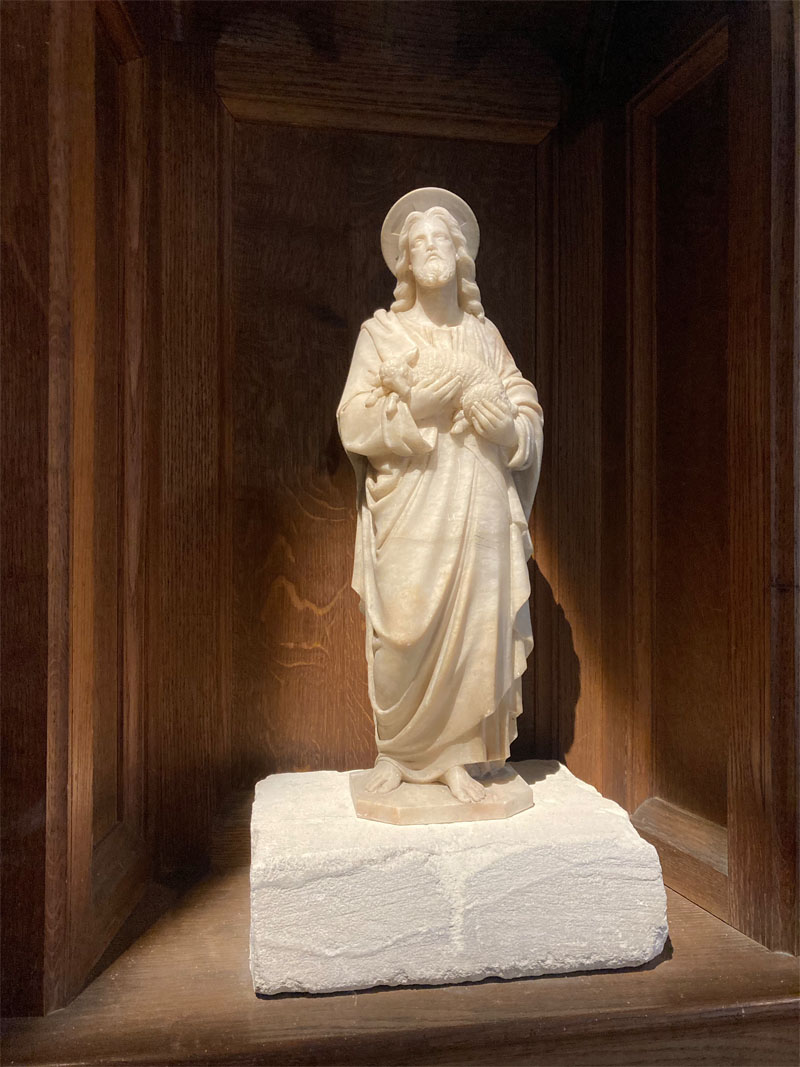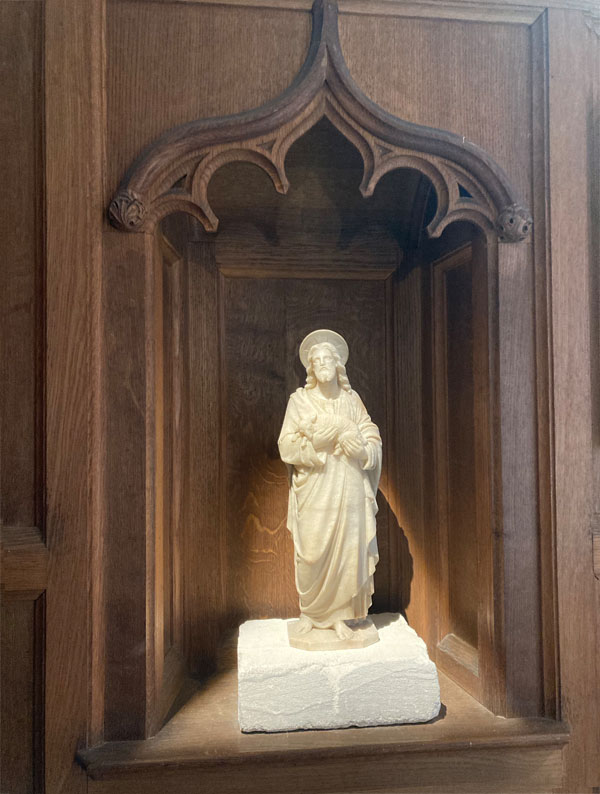The Good Shepherd
THE FIGURE OF THE GOOD SHEPHERD IN THE MEMORIAL CHAPEL
In a wooden niche in the Memorial (or 'Remembrance') Chapel you can find a figure of Jesus, where he is shown as "The Good Shepherd". This figure was originally part of the pulpit that was made in 1893.

The Good Shepherd
In the gospel of John, Jesus likens himself to a Good Shepherd, in contrast to the many bad shepherds who preceded him. These are the words he spoke:
11"I am the good shepherd. The good shepherd lays down his life for the sheep. 12The hired hand is not the shepherd and does not own the sheep. So when he sees the wolf coming, he abandons the sheep and runs away. Then the wolf attacks the flock and scatters it. 13The man runs because he is a hired hand and cares nothing for the sheep. 14I am the good shepherd; I know my sheep and my sheep know me - and I lay down my life for the sheep."
- John 10:11-14
In saying this, Jesus and his audience will have remembered King David’s famous song (or "Psalm"):
1"The Lord is my shepherd. I lack nothing. 2He makes me lie down in green pastures, he leads me beside quiet waters, 3he refreshes my soul."
- Psalm 23:1-3
The 1893 Pulpit
When All Saints Church was enlarged and extended in 1893 under the leadership of the Rev Edward Hardcastle, a new and grander pulpit was made of stone and marble. This pulpit replaced the two wrought iron pulpits with curved steps that had been installed when the medieval church was largely demolished and the present building came into being.
The parish magazine for the 1890’s record that the pulpit was a gift of the Pinder family, who probably had a house in Brookfield Park. In the churchyard there is a memorial stone to four members of the Pinder family including Ann Pinder, who died in December 1890 - not long before work started on the enlargement of the church. She had been married to William Maynard Pinder, who had died 21 years earlier. The parish magazine also tells us that the ‘Misses Pinder’ gave £100 towards the cost of the enlargement and that on the occasion of the rededication of the church (29th June 1893) the Rev. North Pinder ‘preached a beautiful sermon on the Worship of the Church, which was all the better because it came from one who loved Weston and spoke to Weston hearts.’
Removal of the Pulpit in 2024
Church architecture changes in line with changed thinking about the way in which ‘church should be done’. Until quite late in the twentieth century, in many churches, the figure of the priest and what they did in church was kept quite separate (and in some ways, distant) from the congregation. So it was that the priest would speak to the congregation from an elevated pulpit high above their heads (and often the sermon would indeed be ‘above their heads’). Holy Communion was celebrated at the farthest point from the congregation and often with the priest’s back to the congregation.
Towards the end of the twentieth century there was a move to bridge the gap between clergy and laity. This gap was narrowed physically by bringing the communion table much nearer to the congregation, or by having a more modest preaching desk only slightly higher than the congregation. Members of laity also took greater involvement in leading services and preaching.

At All Saints Weston, the pulpit had not been used for preaching for more than 30 years when the refurbishment took place in 2024. It was also very damaged in places. So, it was decided to remove the pulpit altogether. This then allowed a ramp to be constructed in its place, allowing easy access for everyone to that part of the church, which in the past had only been occupied by clergy and choir.
However in removing the pulpit, the figure of Jesus as the Good Shepherd was retained intact, and is now in the Memorial Chapel. It was made by the same person or persons who made the statuette of Christ ascending into glory, which is the centrepiece of the reredos (the decorative panelling on the wall behind the communion rails and table).